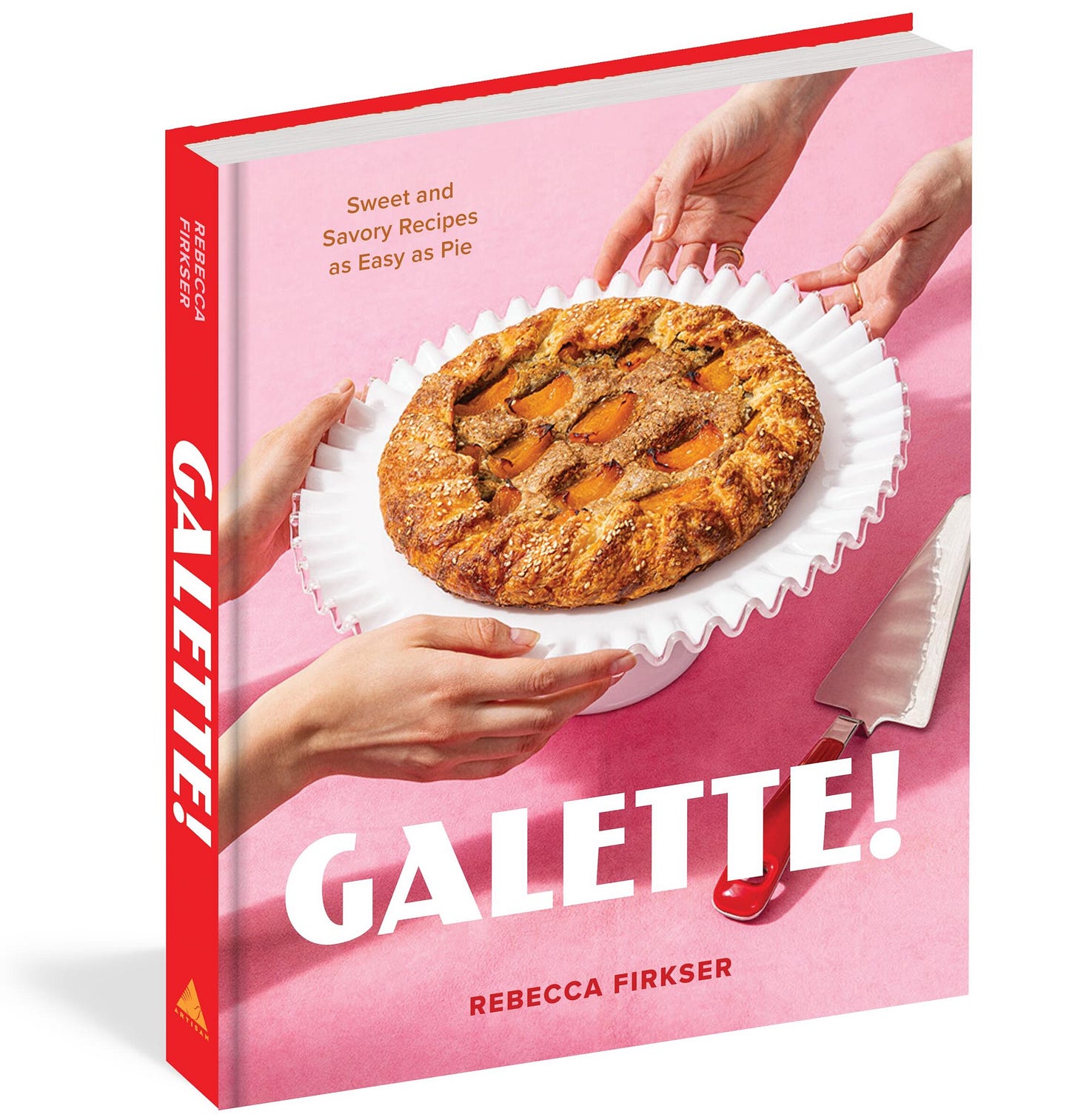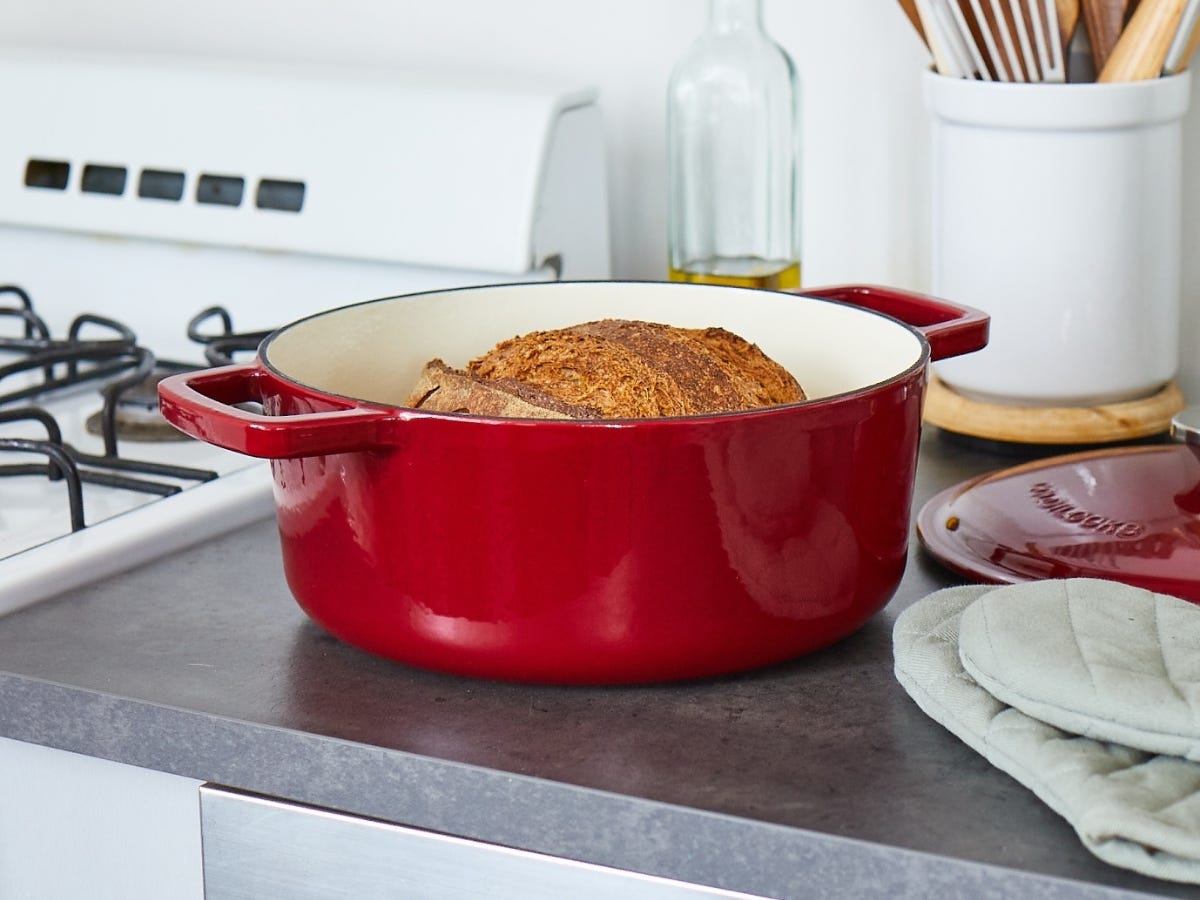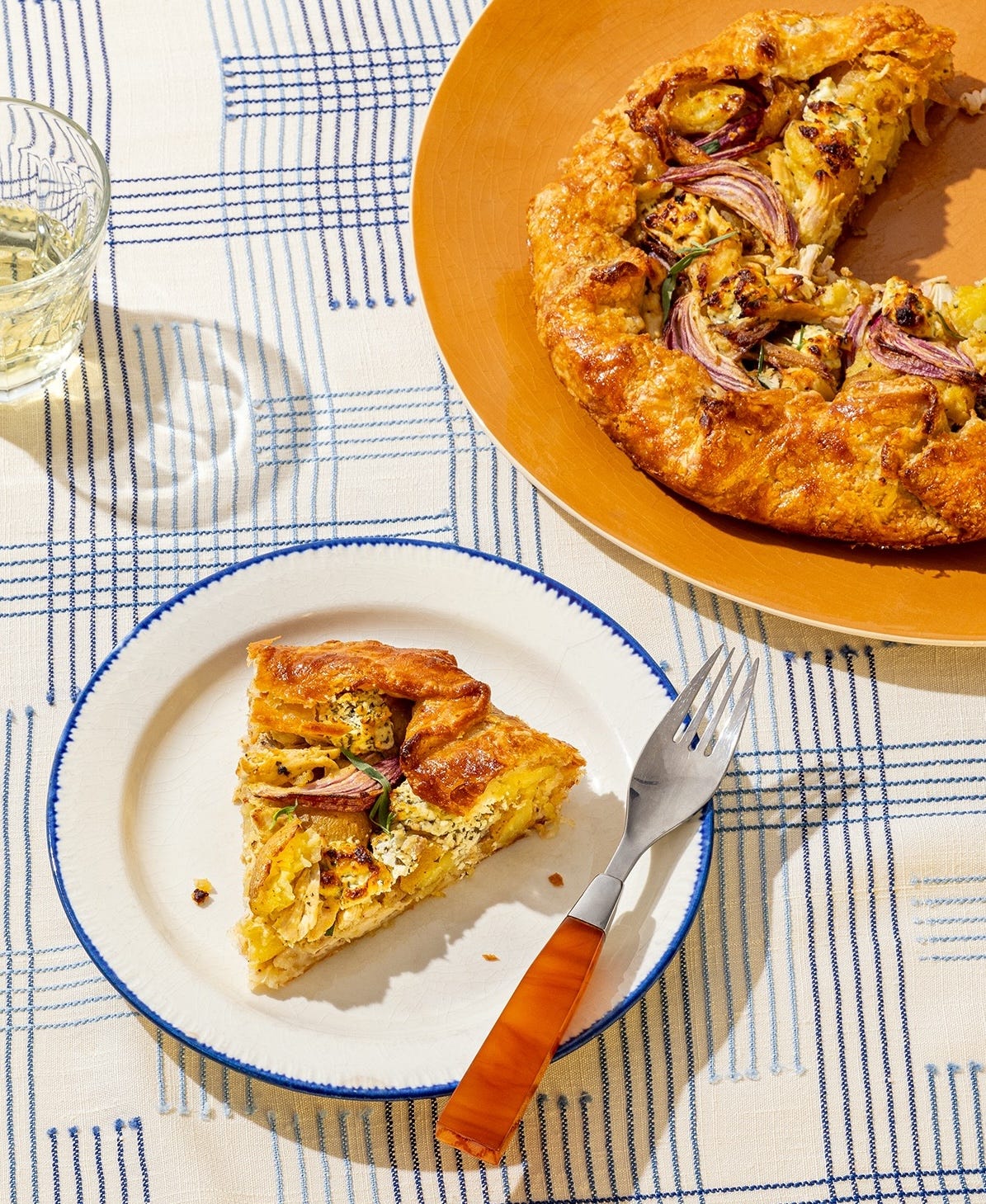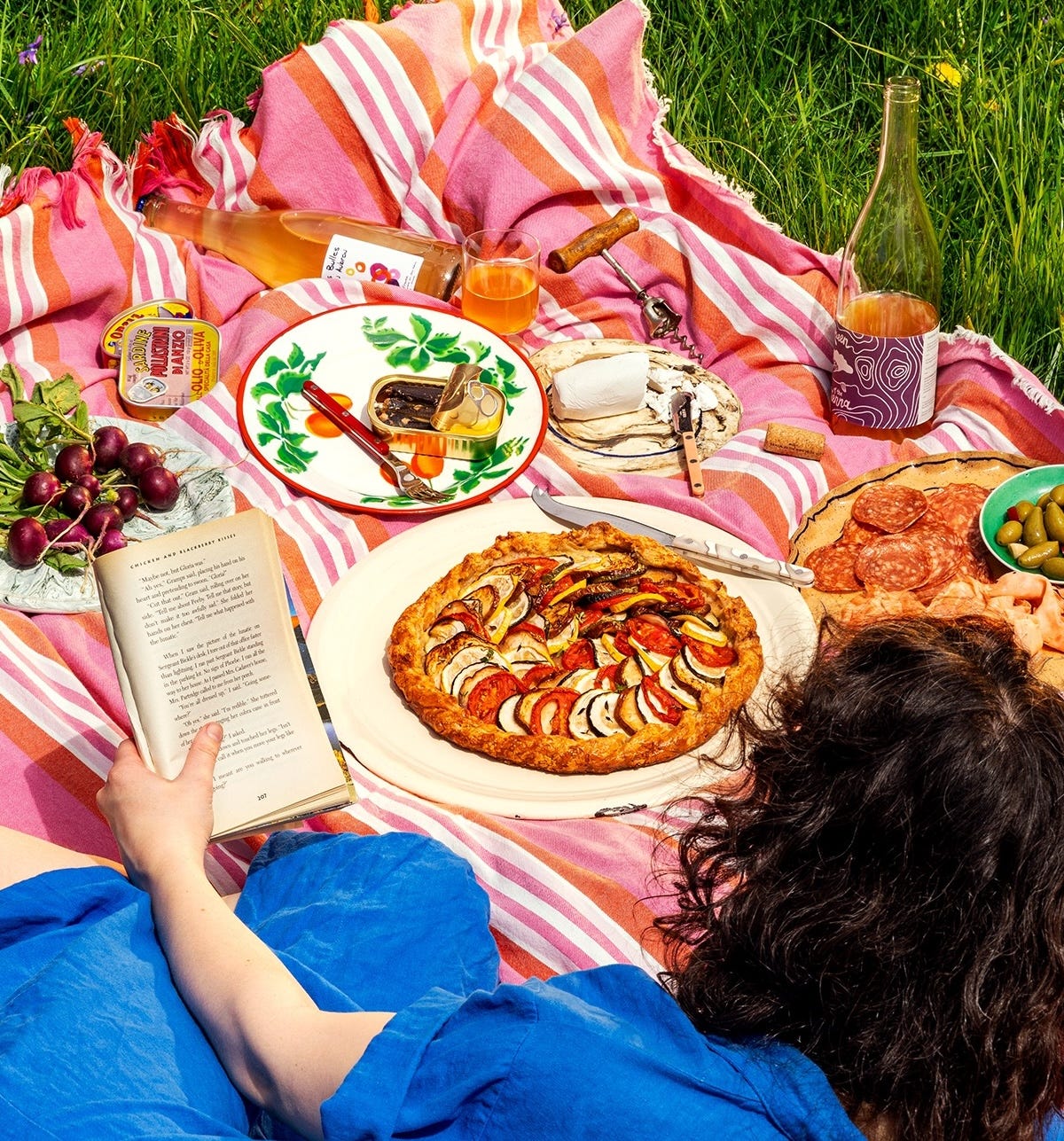Rebecca Firkser’s Best Advice for Cooking on a Budget
Plus: Gorgeous galettes you can make for dinner.
This recipe newsletter is just part of the puzzle. Tune into The Dinner Plan podcast to get full conversations—and then jump into this massive list of all of my guests’ favorite cookbooks. Catch up on my chat with Molly Baz and Hailee Catalano, and don’t miss the East Fork Pottery discount here. Buying through the affiliate links there (or in this send) will help to keep the dinner inspiration coming.
“Honestly,” says cookbook author Rebecca Firkser, “my favorite thing to do is just: condiment, can of something, pasta or grains. And whatever veg I can find.”
The can could be chickpeas or white beans or sardines or other tinned fish. Frozen peas or hearty greens can go in the cooking water for the last moments with the pasta or grains.
Sometimes she opens a jar of harissa, sometimes it’s kimchi for brightness, or just a shake of furikake. Or maybe the condiment is the quick green sauce she’s been making from rooftop chives and preserved lemons lately.
The specifics change, but the template holds. It’s something you can lean on.
Rebecca’s a great source for advice on budget-minded cooking—she’s written regularly about the topic since 2021. Rebecca shares a few crucial grocery tips on this week’s podcast episode, plus a recommendation for a dinner she makes once a week, year round.
Rebecca’s first book, Galette!, isn’t just your new bible on the art of effortless, rustic desserts—it’s a treasure trove of savory recipes, too. You’ll find two picnic favorites below: a goat cheese and rotisserie chicken situation and another for ratatouille lovers.
Win a copy of Galette!
This week, one paid subscriber to The Dinner Plan will win a copy of Rebecca’s delightful book as a thank you for your support.
To enter to win, be sure you’re signed up as a paid subscriber by end of day Sunday, June 29, 2025.
There’s nothing else you need to do. But I do really appreciate your clicking on the ❤️ at the bottom of the page and leaving a little comment to help bring this newsletter to the attention of new readers. Better yet? Share it with a friend!
Giveaway winner will be alerted by Substack DM and email—be sure to check your messages! If there’s no answer from either within 48 hours, we will move on to another winner. U.S. addresses only, 18+. Giveaway not sponsored or administered by Substack. Ends Sunday, June 29, 2025.
Rebecca mentioned:
FreshDirect giardiniera is currently out of stock; Divina Giardiniera is the other favorite we mentioned.
Or make Hailee Catalano’s Chicago-Style Fennel Giardiniera (from By Heart, excerpted on WTTW)
Chive and Preserved Lemon Green Sauce (Nickel & Dine)
Zaynab Issa’s Halal Cart Chicken Salad (Bon Appétit)
Kay Chun’s Tofu With Sizzling Scallion Oil (NYT Cooking; gift link)
Kitty Coles: Make More With Less (Bookshop here)
Samin Nosrat: Salt Fat Acid Heat (Bookshop here), especially the Bean and Kale Soup, and the Persian-ish Rice.
Samin’s new book, Good Things (Bookshop here)
Nicola Lamb: Sift (Bookshop here)
Nordicware half sheet cover (or full set with sheetpan and cover)
Amatriciana for a Crowd
Maggie mentioned:
Melissa Clark’s Pressure Cooker Stock (reprinted from Dinner in an Instant)
Carolyn Cope’s BBQ Pulled Chicken in an Instant Pot (Umami Girl)
Maggie’s most-repeated recipes of summer
Rachel Gurjar’s Chickpea-Potato Chaat (Epicurious)
State Bird Provisions Corn Pancakes With Mt. Tam Cheese (Food + Wine)
King Arthur Baking podcast pizza episode
A MESSAGE FROM OUR SPONSOR
At just $85, the 6-Quart Dutch Oven from Goldilocks is an incredible deal. It’s made from cast iron for excellent heat retention and finished with an enamel coating for easy maintenance. Oversized loop handles and a super-wide base make it a joy to cook with. For great performance, free shipping, free returns, and a lifetime warranty, check it out at cookgoldilocks.com.
Rotisserie Chicken, Potato, and Chèvre Galette
Excerpted with permission from Galette! by Rebecca Firkser (Artisan Books). Copyright © 2025.
If chicken pot pie went on a French vacation, I imagine it’d come back looking something like this. Shredded rotisserie chicken and crushed potatoes are dressed with Dijon mustard and wine, then get cozy with an herb-spiked chèvre. A meal unto itself, it’s perfect to make for a picnic (though no one will mind if you serve slices alongside salad or some crunchy veg) and is just as good at room temperature as it is hot from the oven. With galettes like these, who needs a sandwich?
Variation: For a Buffalo wing–inspired version, swap in crumbled blue cheese for the chèvre; omit the thyme and tarragon; add ½ cup (50 g) sliced celery along with the chicken; and swap in store- bought Buffalo wing sauce for the mustard, with more for serving.
SERVES 4 TO 6
12 ounces (340 g) tiny creamer or fingerling potatoes, scrubbed
2 tablespoons plus ¼ teaspoon Diamond Crystal or 1 tablespoon plus ⅛ teaspoon Morton kosher salt, plus more to taste
1 lemon
6 ounces (170 g) chèvre
2 tablespoons fresh thyme leaves, finely chopped
2 tablespoons fresh tarragon leaves, finely chopped
Freshly ground black pepper
3 tablespoons (45 g) Dijon mustard
3 tablespoons (45 g) dry white wine or vermouth (or fresh lemon juice)
2 tablespoons olive oil
2 cups (300 g) shredded rotisserie (or any cooked) chicken
1 small red onion (4½ ounces/ 125 g), thinly sliced (about ¾ cup)
Cooking spray or vegetable oil, for the pan
1 standard disk A Good Crust (see below)
Egg wash: 1 large egg, beaten
In a medium pot, combine the potatoes, 2 tablespoons Diamond Crystal or 1 tablespoon Morton kosher salt, and water to cover by 2 inches (5 cm). Bring to a boil over high heat. Reduce the heat to medium-high and cook until the potatoes are fork-tender, about 12 minutes. Drain the potatoes in a colander, rinse with cold water, and let cool. (If not baking the galette today, refrigerate the potatoes in an airtight container for up to 1 week.)
Grate the zest of the lemon into a small bowl; set the lemon aside. Add the chèvre, thyme, tarragon, ¼ teaspoon Diamond Crystal or ⅛ teaspoon Morton kosher salt, and a few grinds of pepper and fold and smash with a spatula to combine. Refrigerate until you’re ready to add it to the galette (or in an airtight container for up to 2 days).
In a large bowl, whisk together the mustard, wine, and oil.
When the potatoes are cool to touch, gently crush them with your hands or the bottom of a cup and place in the large bowl with the mustard mixture. Fold in the chicken, onion, and the chèvre mixture (broken into small clumps) until combined. Season with salt and pepper to taste.
Preheat the oven to 425°F (220°C) with a rack positioned in the center. Place a sheet pan in the oven to preheat. Remove the rested dough from the refrigerator and let it sit out for 5 to 10 minutes (this allows the dough to soften slightly, making it easier to roll out, without getting too warm).
Grease a 9- or 10-inch (23 or 25 cm) cast-iron skillet, pie plate, or cake pan with cooking spray. Dust a work surface lightly with flour. Unwrap the dough, sprinkle it with flour, and use a rolling pin to roll it out, flipping and turning the dough and adding more flour as needed to avoid sticking, into a round about 13½ inches (34 cm) in diameter and between ⅛ and ¼ inch (3 and 6 mm) thick.
Spoon the chicken mixture into the crust. Fold the edges of the crust over the filling toward the center, overlapping and pleating as desired. Freeze the galette for 10 minutes.
Remove the galette from the freezer and brush the egg wash over the exposed crust.
Place the skillet on the preheated sheet pan in the oven. Bake until the crust is starting to turn golden, 12 to 15 minutes. Reduce the oven temperature to 375°F (190°C) and continue to bake until the filling is browned and the crust is deeply golden brown, another 40 to 50 minutes, rotating the pan front to back halfway through.
Remove the galette from the oven and cool, uncovered, for 25 minutes or up to 2 hours. Cut the reserved lemon into wedges. Slice the galette and serve with lemon wedges for squeezing.
Leftovers can be stored in an airtight container in the refrigerator for up to 2 days. Reheat on a sheet pan in a 350°F (180°C) oven until warmed through, about 10 minutes.
A Good Crust
Excerpted with permission from Galette! by Rebecca Firkser (Artisan Books). Copyright © 2025.
A galette is essentially half crust and half filling, so the dough’s flavor is of the utmost importance. Butter, as opposed to shortening or another fat, makes the richest, most flavorful pastry. Sugar balances the salt and fat and aids a bit with browning—include it for sweet and savory galettes alike. Add a water-vinegar mixture by the splash for hydration. Folding the dough over itself a few times brings the mixture together and makes an extra-flaky crust.
The butter must stay cold in order for the dough to maintain its structure, then slowly melt and puff in the oven. To ensure this, chill the wet ingredients before they’re incorporated and bring the dough together quickly. It’s not a race, but don’t stop for a phone call halfway through. Save that pause for after you’ve wrapped up the dough, when it absolutely needs at least 2 hours’ rest to relax and hydrate completely before being rolled out.
This recipe makes enough dough for 2 standard galettes (or 4 tiny ones per disk of dough). Make one galette today, freeze a disk of dough for later. Alternatively, combine the entire batch of dough into one “XL” crust, for a sheet pan–sized slab or an extra-tall galette baked in a springform pan.
MAKES 2 STANDARD DISKS OR 1 XL DISK
½ cup (115 g) water
1 tablespoon apple cider vinegar
2¾ cups (345 g) spooned and leveled all-purpose flour, plus more as needed
1 tablespoon sugar
1½ teaspoons Diamond Crystal or ¾ teaspoon Morton kosher salt
2½ sticks (10 ounces/285 g) unsalted butter, cut into ½-inch (13 mm) cubes, chilled
In a liquid measuring cup or a small bowl, combine the water and the vinegar. Place this in the freezer while you work on the next steps.
In a large bowl, use your fingers or a fork to combine the flour, sugar, and salt.
Add the butter to the large bowl and use your fingers or a fork to gently toss around the butter to coat it in the flour mixture. Use your fingers to smash and rub the butter into the flour mixture until it forms flat pieces mostly the size of cannellini beans (about ¾ inch/2 cm) with some smaller (think chickpeas and lentils; about ½ and ¼ inch/13 and 6 mm). The mixture should still look dry and crumbly.
Remove the water-vinegar mixture from the freezer. Drizzle half of the water-vinegar mixture over the flour-butter mixture. Working from the bottom of the bowl up, use your fingers or a fork to gently toss the mixture together, as if you were tossing a salad. Drizzle over another splash of the water-vinegar mixture and toss. Continue to drizzle and toss until a shaggy, chunky mixture forms. It should not be completely combined yet, but there also should be no totally dry areas of flour (look for pebbles of moistened flour, not pure powder). You may not need the full amount of water-vinegar mixture. When in doubt, err on the dry side: You can always add liquid, but you can’t take it away.
Here’s how to know if you’re in a good place: Pick up a handful of the mixture and squish it. It should mostly hold its stuck-together shape; if not, drizzle an additional 1 teaspoon water-vinegar mixture on the driest areas and toss again, repeating until it holds together.
Dump the mixture onto a clean work surface and use your hands to pat it together into a rectangular mass about 1 inch (2.5 cm) thick. If you find any more areas that look totally dry, drizzle them with another 1 teaspoon water-vinegar mixture.
Use your hands or a bench scraper to fold the mass of dough over itself. Press down the dough until it’s about 1 inch (2.5 cm) thick again. (The dough shouldn’t be moist or sticky, but if so, sprinkle it with a bit of flour as you fold.) Repeat folding and pressing down the dough two or three times. As you fold the dough over itself, the shaggy mass will form into a cohesive dough (this is also going to help the crust bake off extra-flaky). The butter should not blend all the way in, and the surface of the dough should look like marble or wood grain.
If making a standard disk (check your galette recipe): Divide the dough in half, placing each half on a piece of plastic wrap. If making an XL disk (check your galette recipe): Place the entire slab of dough on a piece of plastic wrap.
Wrap the dough in the plastic wrap, then press it into a round or rectangle (see Note below) about ¾ inch (2 cm) thick. Refrigerate for at least 2 hours and up to 5 days. (Alternatively, freeze for up to 3 months, then let thaw in the refrigerator overnight.)
NOTE: Shaping your dough into the approximate shape of your galette (round, rectangular, etc.) will be helpful when rolling it out, but it’s not imperative to achieve success. In fact, I typically shape my dough into squares for easy stacking in the freezer.
Warm-Weather Tian
Excerpted with permission from Galette! by Rebecca Firkser (Artisan Books). Copyright © 2025.
You’ve probably heard of ratatouille, the rustic Provençal dish of stewed tomatoes, eggplant, and zucchini; but how about tian? Similar to ratatouille in ingredients but far more elegant in presentation, tians feature a captivating spiral or neat rows of tiled vegetable rounds. (Fun fact: The French word tian refers to both the dish and the earthenware vessel in which it’s traditionally baked—I think it’s still okay to call it as such when baked in pastry dough.)
SERVES 4 TO 6
1 standard disk A Good Crust (see above)
6 ounces (170 g) plum, Campari, or small heirloom tomatoes (2 to 3), sliced ⅛ inch (3 mm) thick
6 ounces (170 g) green and/ or yellow zucchini (2 to 3 small), sliced ⅛ inch (3 mm) thick
One 6-ounce (170 g) Japanese or Chinese eggplant, sliced ⅛ inch (3 mm) thick
3 tablespoons (40 g) olive oil
¾ teaspoon Diamond Crystal or
¼ teaspoon Morton kosher salt, plus more to taste
2 tablespoons Dijon or whole-grain mustard
6 garlic cloves, thinly sliced 1 tablespoon fresh thyme or oregano leaves, plus more for serving
Freshly ground black pepper
Egg wash: 1 large egg, beaten
Line a sheet pan with parchment paper. Remove the rested dough from the refrigerator and let it sit out for 5 to 10 minutes (this allows the dough to soften slightly, making it easier to roll out, without getting too warm). Dust a work surface lightly with flour. Unwrap the dough, sprinkle it with flour, and use a rolling pin to roll it out, flipping and turning the dough and adding more flour as needed to avoid sticking, into a round about 13½ inches (34 cm) in diameter and between ⅛ and ¼ inch (3 and 6 mm) thick. Refrigerate on the sheet pan while you make the filling (it takes a while to fill the crust so it’s best for the dough to be extra-cold).
In a medium bowl, toss the tomatoes, zucchini, and eggplant with 2 tablespoons of the oil and the salt. Let sit for at least 10 minutes and up to 30 minutes to draw out some moisture.
Preheat the oven to 425°F (220°C) with a rack positioned in the center.
Brush the mustard over the crust, leaving a 2-inch (5 cm) border. Scatter the garlic and thyme over and season with more salt and pepper. Leaving any excess liquid in the bowl, arrange the produce in rows or concentric circles, alternating between tomatoes, zucchini, and eggplant.
Twist and crimp the crust border over itself to make a 1-inch (2.5 cm) border. (Alternatively, as for any other galette, fold the edges of the crust over the filling toward the center, overlapping and pleating as desired.) Freeze the galette for 10 minutes.
Remove the galette from the freezer and brush the egg wash over the exposed crust. Drizzle the remaining 1 tablespoon oil over the filling and season with more pepper.
Bake until the crust is starting to turn golden, 12 to 15 minutes. Reduce the oven temperature to 375°F (190°C) and continue to bake until the filling is starting to brown and the crust is deeply golden brown, another 40 to 50 minutes, rotating the sheet pan front to back halfway through.
Remove the galette from the oven and cool, uncovered, for 15 minutes or up to 8 hours.
Leftovers can be stored in an airtight container in the refrigerator for up to 3 days. Reheat on a sheet pan in a 350°F (180°C) oven until warmed through, about 10 minutes.









Love Rebecca’s approach to budget-friendly lining!
A dinner galette is such an under-appreciated option! Such a great way to use things up in a meal that still feels special.